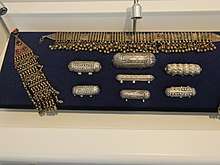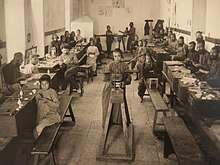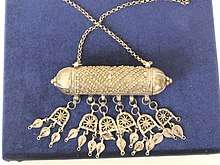Yemenite silversmithing
_for_The_Israel_Museum_-_b.jpg)
Jewish silversmiths who hailed from Yemen were highly acclaimed craftsmen who dominated craft production in precious metals in the southern Arabian peninsula, from the 18th through the mid-20th century, a period and region during which Muslims did not engage in this work. These Yemenite silversmiths were noted for their use of fine granulation and filigree, producing such ornaments as women's bracelets, necklaces, finials, etc. that are renowned the world over.

History
Yemenite silversmiths, a trade held almost exclusively by Jews living in the traditional Yemeni society, were active from at least as far back as the mid 1700s.[1][2] The largest clientele for jewelry made of gold and silver were women, and the amount of jewelry worn was often an indicator of the woman's status.[3] Some Yemenite silversmiths migrated to Israel in the late 1800s, a migration that continued in the early 1900s. In the early 20th-century, the Bezalel Academy of Arts and Design employed many Yemenites in the production of fine silver jewelry.[4]
Between June 1949 and September 1950, almost the entire Jewish community in Yemen, including nearly every silversmith in the country, migrated to Israel in an airborne mass migration known as Operation Magic Carpet. Muslims appear to have entered silversmithing in the Yemen in the mid-1900s as the Jews departed for Israel.[5] Mass-produced gold and silver jewelry began to be imported into the Yemen in the 1930s, and dominated the market by the end of the 20th century, causing traditional silversmithing to dwindle.[6][7][8]

According to Mark. S. Wagner, Professor of Arabic literature and Islamic Law at Louisiana State University, it is difficult to clarify precisely how silver- and gold-smithing came to be regarded as occupations that were too impure for Muslims in the Yemen to engage in; jobs that were similarly regarded in traditional Yemeni culture included pottery making, disposing of human waste from latrines, processing the carcasses of dead animals, soap-making, tanning, and making cakes of cow dung for use as fuel.[6] Jewish silversmiths in this region sometimes moonlighted as dentists, since their jewelers pliers could be used to draw teeth.[6]
Yemenite silversmiths melted silver coins to produce Janbiya (dagger) hilts, bridal jewelry and other silver objects.[8][9] The Maria Theresa thaler, minted continuously since 1741, was especially favored for its consistent silver content and fineness,[8] and which currency was widely in use in Yemen owing to the Mocha coffee trade with the French, and a Yemeni request that its produce be paid with thalers.[10]
Style and silver content
Yemenite silver-work is noted for its intricate use of filigree and fine granulation.[2][5] Jewelry containing a high silver content was called by local Jews, ṭohōr, or in the Arabic tongue, muḫlaṣ, the intent being to jewelry whose silver content ranged from 85% to 92% (sterling silver), while the rest being copper. The disadvantaged of the cities and in the rural regions, as well as Bedouins, would routinely order jewelry whose silver content was lower, up to 60% silver, the remainder of which being copper and which had the name of fuḍah. A lower quality silver was called niṣfī, a word having the connotation of “half,” implying that it was made half of silver and half of copper.[11]
Labbe necklaces
_for_The_Israel_Museum.jpg)
Among the variety of jewelry known in Yemen, the labbe necklace is the most impressive in its complexity. A highly skilled work of Jewish silversmiths, it is a testimony of exquisite craftsmanship, requiring painstaking work and a developed artistic sense, expressed by the harmonious and aesthetic blend of its many parts. The labbe is a popular piece of jewelry among Jewish and Muslim women alike. In Arabic, the name labbe indicates the sunken place beneath the Adam's apple on the neck, where it is worn.[11]
Labbe necklaces made of applied filigree, being open and airy like the interlaced net of a spider’s web, became more popular during the Ottoman conquest of Yemen, in the mid-19th century, and were given the name labbat šabek in Sana'a, after its technique. Until then, most were prepared by using casting techniques, and embossing and fashioning from solid pieces.[11] Only a few were made from silver.[12] The labbe is traditionally made from dozens of components arranged in horizontal rows, or storeys (projected lines). The top row forms the base of the necklace, with connecting parts (usually serial pendants) densely strung upon a cotton or silk thread, extending downwards lengthwise, in identical columns and which form the horizontal lines. It consists of one row – or more – of parts, whose shapes are varied: diamond-shaped rhomboids, squares and rectangles, round beads or rosettes. Most contain smooth plates of metal, in circular and diamond-shaped (rhombus) forms, and are studded with jewels called in Arabic zihreh, meaning, pearls, amber, corals and colored glass.[11] The artisans would also lavishly apply decorations made from small, rounded silver granules. Coin pendants are characteristic of the labbe necklaces worn by villagers. Large labbe necklaces may have as many as thirty or more rows.[11]
_for_The_Israel_Museum.jpg)
The components are interconnected by coiled rings in the vertical and horizontal rows. The location of the items in the vertical lines are complementary to each other, as well as uniform along all the vertical lines. In the vertical lines there are four to eight items that are connected one beneath the other by a metal wire in the shape of the figure-eight, called in Arabic methamāna, meaning "eight." For most, the edges of the base end with either triangles or cones. Occasionally, motifs used in its base were also incorporated in the body of the labbe, particularly the rosette, the lozenge and the round bead. Labbe necklaces worn by Muslim women typically differed from those worn by Jewish women, insofar that they lacked a base.[11] In labbe necklaces typically worn by Muslim women in central Yemen, they made use of convex components, or motifs that were round and belly-shaped, resembling leaves or barley-grains (Arabic: aqrāṭ she‘iriyāt). In some places, it was common to attach a piece of woven cloth on the back of the labbe, like the inner lining of garments, to protect the clothes and the embroidery, as well as the skin, from abrasions.[13]

Techniques
While silver granules can also be made by dropping melted silver into cold water, in Yemen, most silversmiths used a different technique. The silver granules (šaḏir) were prepared from a silver wire cut into small pieces, which were then concealed within ashes that were heated by a flame, during which heating process they obtained their round shape. From them, they prepared masbūʻāt – the rose-like cluster consisting of seven granules, and matisūʻāt – the diamond-shaped rhombus consisting of nine granules, the mulberry beads known as tūt for the choker necklace (maʻnaqeh), among other things. This process forms granules, or "droplets" that are perfectly round. These were soldered onto the piece of jewelry as desired.
Silver wires were made in Yemen by pouring melted silver into a finger-length mold made from special earth and which was shaped like a tube. A substance similar to borax (known as tinkar in the Yemenite dialect of Arabic - and otherwise known as the "glue of the silversmith") was solely used in Yemen for the purpose of soldering in order to bind together two separate silver pieces (especially for applying fine and delicate work, such as granules, to a silver plate). Cadmium was not used in Yemen for this purpose at all. A different substance was used when soldering wires to a silver plate.
In recent years in Yemen, the silversmith bought all these materials (granules, wires and plates) pre-manufactured.
Silversmith's terminology
- ṭohōr = sterling silver
- fuḍah = alloyed silver
- tinkar = pulver (a soldering powder)
- chabath = slag that comprises letharge of silver (from the silversmith's refinery)
- lāz aswad = niello-decorated
- mshawsaq = rhomboids
- fatil = twisted silver wire
- ṣom = a substance used by the older Yemenites in smelting silver, used primarily in very fine and delicate applications so as not to suffer the silver to melt before it was shaped and applied.
Museum holdings
Yemenite silver is owned by the Israel Museum, The Walters, the Metropolitan Museum of Art, and the British Museum.[2][1][14][15]
Museum exhibitions
- Diadem and Dagger: Jewish Silversmiths of Yemen, Walters Art Museum, 2002-03.[2][16]
- "Silver Speaks: Traditional Jewelry of the Middle East", The Bead Museum in Washington, D.C., 2002–03; Arab American National Museum, 2007–08.[8][17]
See also
Further reading
- Rabbi Joseph Kafiḥ, 'Laz' or 'Kḥal' - technique of producing niello - a blackened glaze on gold; published in: Peʻamim Quarterly - Studies in the Cultural Heritage of Oriental Jewry (ed. Itzhak Bezalel), Jerusalem 1982 - Issue no. 11, pp. 89–93 (Hebrew)
Gallery
 Silver earrings
Silver earrings Mannequin with silver jewelry
Mannequin with silver jewelry Silver craft
Silver craft Yemenite Bracelet with signature of artisan
Yemenite Bracelet with signature of artisan Silver bracelet
Silver bracelet Woman's Headband
Woman's Headband
References
- 1 2 "Necklace". metmuseum.org. Metropolitan Museum of Art (New York). Retrieved 1 August 2017.
- 1 2 3 4 "Diadem and Dagger: Jewish Silversmiths of Yemen". thewalters.org. Walters Art Museum. Retrieved 1 August 2017.
- ↑ Yael Guilat, "The 'Israelization' of Yemenite-Jewish Silversmithing", in: Ascending the Palm Tree – An Anthology of the Yemenite Jewish Heritage, Rachel Yedid & Danny Bar-Maoz (ed.), E'ele BeTamar: Rehovot 2018, p. 227 OCLC 1041776317
- ↑ "The Bezalel Exhibition at Madison Square Garden". The American Hebrew & Jewish Messenger. 16 January 1914. Retrieved 1 August 2017.
- 1 2 Ransom, Marjorie (January 2012). "The Enduring Craft of Yemeini Silver". Saudi Aramco World. Retrieved 1 August 2017.
- 1 2 3 Wagner, Mark A. (2014). Jews and Islamic Law in Early 20th-Century Yemen. Indiana University Press. p. 98. ISBN 0253014921.
- ↑ Akkerman, Ari (5 March 2012). "Will the Jewish silver craft survive in Yemen?". Yemen Times. Retrieved 1 August 2017.
- 1 2 3 4 Ransom, Marjorie (2014). Silver Treasures from the Land of Sheba; Regional Yemeni Jewelry. American University in Cairo Press. p. 219. ISBN 9789774166006.
- ↑ Pomerantz, Batsheva (6 December 2013). "Yemenite steps - near Jerusalem". Jerusalem Post. Retrieved 1 August 2017.
- ↑ Ghalib bin Awadh al-Qu'aiti, The Maria Theresa Thaler in Hadhramaut: Some Reflections, The British-Yemeni Society
- 1 2 3 4 5 6 Aviva Klein-Franke, Silver and Gold Cuirass of Mail (The Labbe Necklaces), pub. in book: Ma'ase Rokem: Dress and Jewelry in the Tradition of the Jews of Yemen (ed. Carmella Abdar), Article: “Shiriyon shel Kesef we-Zahav – ‘Anaqei Ha-labbe (Silver and Gold Cuirass of Mail),” Tel-Aviv 2008, pp. 89–102
- ↑ Ḥibshūsh notes: “Generally speaking, items wrought in silver were very few, and no one asked for them except the royalty and the illustrious men of the kingdom. Tribesmen and most of the public were content with having jewelry made of iron, copper, lead and glass beads... Nowadays, silver products have become more plenteous than the copper and iron once used in the past.” (see Ḥibshūsh 1983, pp. 86–87).
- ↑ Qāfiḥ 1961, pp. 190, 192 Photo 24; Colyer-Ross 1981, p. 108; Janata 1989, Photo 61 on p. 136, the text 38-E on p. 186; Heimberg 1986, p. 84; Untracht 1982, p. 174; Sergeant and Lewcock 1983, p. 540; Muchawsky-Schnapper 2000, pp. 128-129
- ↑ "necklace / qur'an-case / amulet". britishmuseum.org. British Museum. Retrieved 4 August 2017.
- ↑ "Costume and Jewelry: A Matter of Identity". museum.imj.org.il. Israel Museum. Retrieved 4 August 2017.
- ↑ Wecker, Menachem (10 December 2012). "Silversmithing in the Yemen". TheForward. Retrieved 1 August 2017.
- ↑ "Silver Speaks: Traditional Jewelry of the Middle East". Arab American National Museum. Retrieved 1 August 2017.
Bibliography
- Colyer-Ross, H. (1981). Bedouin Jewellery. Fribourg
- Heimberg, U. (1986). Filigran und Granulation: Dekorationstechniken bei südwestarabischen Silberarbeiten, Baessler-Archiv, N.S. LIX/1, Berlin (Reimer)
- Ḥibshūsh, H. (1983). Masot Habshush (The Journeys of Habshush): The Vision of Yemen – Rawʻiah al-Yaman, with an introduction by S.D. Goitein (Hebrew)
- Janata, A. (1989). Jemen: Im Lande der Königin von Saba, Wein (Vienna)
- Muchawsky-Schnapper, E. (2000). The Yemenites: Two Thousand Years of Jewish Culture. Jerusalem
- Qāfiḥ, Y. (1961). Halikhot Teman, Jerusalem (Hebrew)
- Sergeant, R. B. & Lewcock, R. (1983). Sana: An Arabian City, London
- Untracht, O. (1982). Jewellery Concepts and Technology. NW London
External links
- Association for Society and Culture - Netanya Labbe necklace